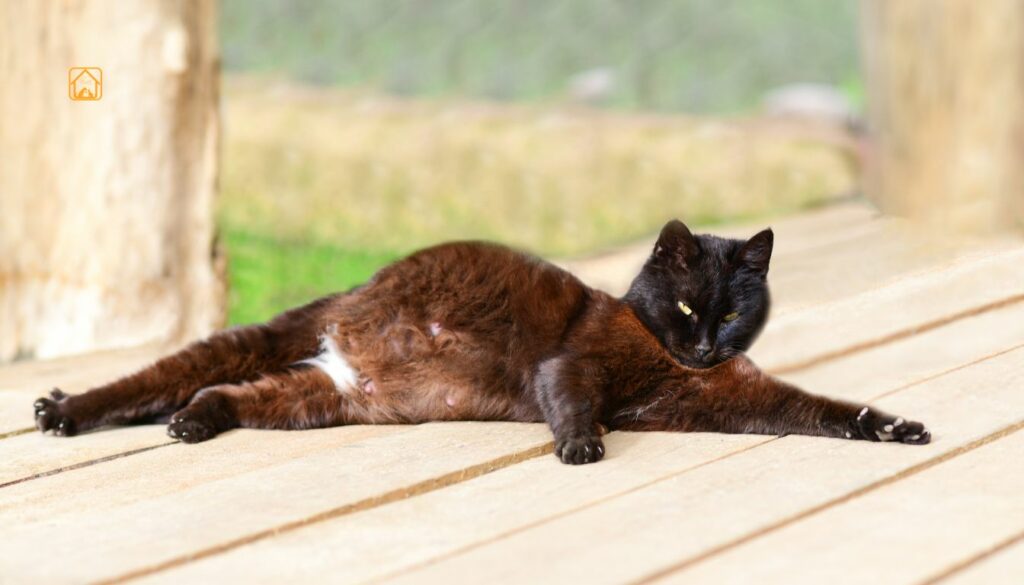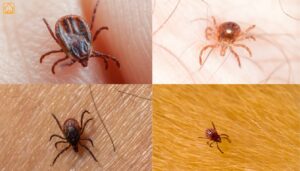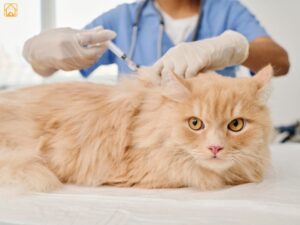Cat Reproduction Basics and When Cats Can Get Pregnant
Let’s start at the beginning: cats reach sexual maturity shockingly early, sometimes as young as four months old. That’s right. For many breeds, it’s between four to six months, though some may be a little later. This early start is why vets and shelters recommend spaying or neutering around four months to prevent surprise litters.
Female cats (called queens) have a unique reproductive cycle. They’re seasonally polyestrous, which means they come into heat multiple times a year, usually triggered by longer daylight hours. You might notice your cat rolling around, meowing more, or becoming extra affectionate. These are signs she’s in heat and ready to mate.
Unlike some animals, cats are induced ovulators. That’s a fancy way of saying they only release eggs after mating, not on a regular cycle. Here’s the quirky part, a female can mate with different males during one heat cycle, so her kittens might have multiple fathers.
- Estrus (heat) period: Usually lasts 4-7 days, but can be longer.
- Mating: Stimulates ovulation; a queen may mate several times with different toms.
- Fertilization: After eggs are released, they travel to the uterus where they can be fertilized by sperm that survive several days.
Once fertilized, the journey to motherhood begins. The cat pregnancy period officially starts
How Long Are Cats Pregnant? Understanding the Cat Pregnancy Timeline
The cat pregnancy period, also called gestation, typically lasts between 63 and 65 days. That’s about nine weeks, though it can vary a little depending on the individual cat breed. Some cats deliver as early as day 58, while others may go a few days over.
Cat Pregnancy Duration
- Average cat pregnancy length: 63-65 days (about two months).
- Shortest recorded pregnancies: 58 days (kittens may be premature).
- Longest normal pregnancies: Up to 70 days (rare, but possible).
- Persian cat pregnancy period: Usually within this same range
So, how long does cat pregnancy last? Most pet parents can expect kittens to arrive about nine weeks after mating. If you’re wondering about the cat pregnancy timeline or using a cat pregnancy calculator, remember to start counting from the day of mating (if known).
Early Signs and Symptoms of Cat Pregnancy
Spotting the early signs of cat pregnancy can feel a bit like detective work. In the first couple of weeks, changes are subtle. But there are a few clues that can help you figure out if your cat might be expecting.
Common Early Cat Pregnancy Symptoms
- Pinking up: Around 16-22 days after mating, your cat’s nipples become pinker and more prominent.
- Mild weight gain: Some cats gain a little weight early on.
- Change in appetite: She may eat more, or sometimes less than usual.
- Behavioral shifts: Pregnant cats might be more affectionate, quieter, or seek out extra cuddles.
Pregnancy Timeline
Many pet parents wonder how to tell where their cat is in the pregnancy timeline. The process is usually divided into three trimesters:
- First trimester (days 1-21): Subtle changes, often not obvious to pet parents.
- Second trimester (days 22-42): Physical and behavioral changes become noticeable.
- Third trimester (days 43-65): Belly grows, nesting starts, kittens are almost ready.
| Stage | Time Frame | What to Expect |
| First Trimester | 1-21 days | Minimal outward signs, possible appetite change, mild behavior shifts |
| Second Trimester | 22-42 days | Belly begins to round, nipples “pink up,” increased affection |
| Third Trimester | 43-65 days | Belly clearly visible, nesting, possible decrease in appetite right before labor |
Curious about how to calculate your cat’s due date? A cat pregnancy calculator can help estimate, but unless you know the exact mating date, it’s usually a best guess. Veterinarians can confirm pregnancy and estimate timing with exams or ultrasounds.
Cat Pregnancy Stages: Week-by-Week Development
Cat pregnancy can be broken down into stages, with distinct changes as each week passes. Here’s how the journey usually goes:
| Week | What Happens |
| Weeks 1-2 | Little outward change; fertilization and embryo development inside. |
| Weeks 3-4 | Nipples pink up, mild appetite increase, subtle weight gain. |
| Weeks 5-6 | Belly becomes rounder, appetite often increases, behavioral changes like nesting may begin. |
| Weeks 7-8 | Obvious belly enlargement, kittens can sometimes be felt moving, nesting behavior ramps up. |
| Week 9 | Restlessness, decreased appetite, seeking seclusion, labor is near. |
Some cats keep their pregnancy under wraps until the last couple of weeks. If you’re watching cat pregnancy week by week, look for gradual changes in body shape and temperament. It’s a little like waiting for a surprise party, sometimes, the clues are subtle until the very end!
How to Tell If Your Cat Is Pregnant: At-Home and Veterinary Tests
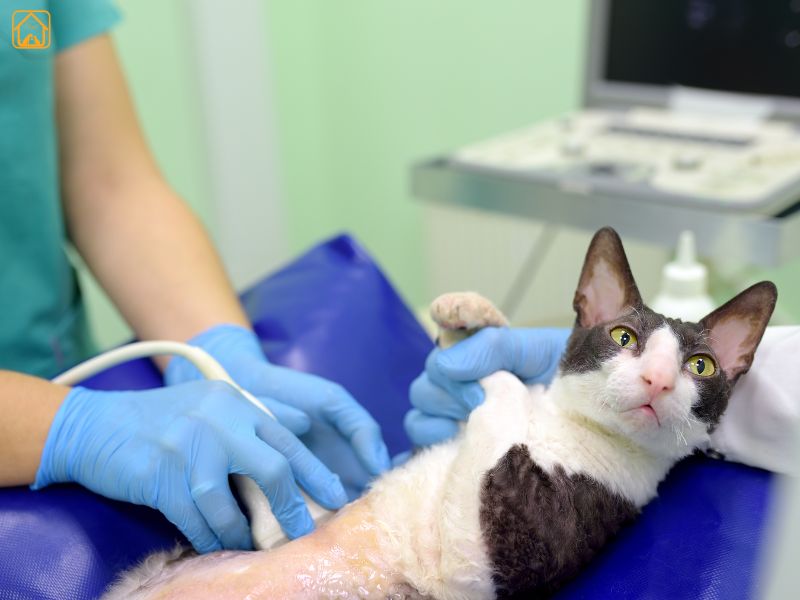
Wondering about a cat pregnancy test? While there isn’t a “pee-on-a-stick” test for cats, there are ways to confirm pregnancy both at home and with your vet’s help.
Cat Pregnancy Test Options
- At-home observation: Watch for symptoms like pinking up, weight gain, and nesting behavior.
- Veterinary palpation: Around 17-25 days in, a vet can gently feel for developing kittens.
- Ultrasound: Detects kittens as early as 3 weeks, confirms pregnancy and estimates litter size.
- X-ray: After 6 weeks when kitten skeletons are visible, helps count kittens.
If your cat is showing signs but you’re unsure, a visit to the vet is the best way to confirm pregnancy and rule out other issues (like false cat pregnancy or illness).
Caring for a Pregnant Cat: Nutrition, Environment, and Health
Pregnancy takes a lot of energy, and your cat will need extra care. Here’s what helps her stay healthy:
Nutrition During Pregnancy
During cat pregnancy, your queen’s body works overtime. She needs extra calories and nutrients to support her growing kittens. That means switching her to a high-quality kitten food (yes, kitten food!) by week 3 or 4 of pregnancy. Kitten food offers the higher protein, fat, and essential nutrients mom and babies need.
- When to switch: Around the 3rd week of pregnancy
- How much to feed: Offer more frequent, smaller meals as her belly grows
- What to avoid: Don’t give supplements unless your vet specifically recommends them
Your cat’s appetite may change as the pregnancy progresses. Some queens are ravenous, others get a little picky, especially as kittens take up more space. If she seems uninterested in food for more than a day, call your vet. Dehydration and weight loss are never normal in cat pregnancy.
Comfortable Environment: Safety, and Nesting
Your pregnant cat will want a quiet, private space to feel safe as her due date approaches. Start preparing a nesting area a couple of weeks before you expect the kittens. It doesn’t have to be fancy, a cardboard box lined with soft, washable bedding works great. Place it somewhere calm, away from noisy areas or other pets.
- Keep her indoors during the last weeks of pregnancy to prevent stress or accidental injury
- Offer plenty of clean water and keep her litter box nearby, but not right next to her nest
- Check the bedding daily and change it if soiled
Health and Vet Care
- Continue routine parasite prevention, ask your vet about safe products.
- Vaccines are best given before pregnancy; avoid live vaccines during gestation.
- Bring a fecal sample to your vet to check for worms, as parasites can affect kittens.
- Monitor for signs of illness: vomiting, diarrhea, loss of appetite, or unusual discharge should prompt a vet visit.
And don’t forget, pregnant cats need plenty of love and reassurance. Talk to her gently, offer extra pets, and let her rest when she wants. Honestly, it’s a bit like caring for an expectant friend, just with more purring.
Preparing for Signs of Labor and Delivery
As your cat nears her due date, she’ll show signs of nesting and might seem restless. Here’s how to help her prepare for a smooth delivery:
Signs Labor Is Near
- Nesting: Your cat spends more time in her chosen spot, kneading or rearranging bedding
- Restlessness: Pacing, frequent trips to the litter box, or hiding more than usual
- Appetite drop: She may stop eating 12–24 hours before labor starts
- Temperature drop: Her rectal temperature may fall below 100°F (37.8°C) within 24 hours of labor
- Increased grooming: Especially around her belly and genital area
Setting Up for Labor
- Choose a clean, draft-free area for her nesting box; keep it private but easy to observe.
- Line the box with soft, washable bedding (towels, old sheets).
- Keep the room warm, especially for newborn kittens (ideally 85-90°F during their first week).
What to Expect During Labor
- Your cat may stop eating 24 hours before labor.
- Early labor: restlessness, frequent visits to the nest, possible panting.
- Active labor: visible contractions, kitten delivery every 5-30 minutes.
- Cats may pause between kittens for up to an hour (or even longer, rarely).
| Stage | What Happens | How Long |
| Stage 1 | Cervix relaxes, mild contractions begin | Up to 24 hours |
| Stage 2 | Active labor, visible straining, kittens start arriving | 5–30 min per kitten |
| Stage 3 | Delivery of placenta (afterbirth) for each kitten | Usually right after each kitten |
Postpartum Cat Care: Mother and Kittens After Birth
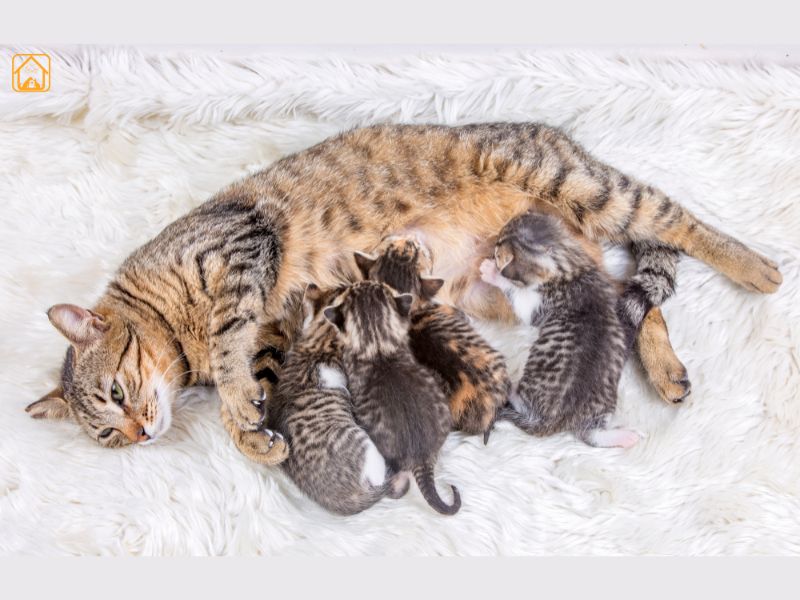
Congratulations, kittens have arrived! But now what? The first few days after delivery are critical for both mom and babies. Cat pregnancy is a marathon, but postpartum care is just as important.
Right After Birth
- Let your queen clean her kittens. This helps stimulate their breathing and bonding.
- Make sure each kitten is nursing within an hour or two of birth, colostrum (first milk) is vital.
- Keep the nesting area clean and dry. Replace soiled bedding gently, without disturbing the family too much.
Mom may eat the placentas, this is normal and provides nutrients. If any kittens seem cold, weak, or can’t nurse, call your vet right away.
Nutrition and Hydration for Mom
- Continue feeding high-calorie kitten food
- Offer fresh water at all times
- Provide food near the nest, as she may not want to leave her babies
Her appetite may be huge, she’s producing milk! Don’t restrict her food.
Caring for the Kittens
- Kittens should double their birth weight in the first week
- They’re born with eyes closed and ears folded, these will open between 7–14 days
- Keep the nest warm (85–90°F) for the first week, then slowly lower the temp
Special Cases: False Pregnancy, Stopping Cat Pregnancy, and Breed Differences
Sometimes, things aren’t as straightforward as they seem. Here’s what to know about special cases:
False Pregnancy
Some cats show signs of pregnancy, enlarged nipples, nesting, even lactation, without actually carrying kittens. This is called false cat pregnancy. Most cases resolve on their own, but check with your vet if you’re unsure.
How to Stop Cat Pregnancy
Spaying (ovariohysterectomy) is the only reliable way to prevent or end pregnancy. If your cat might be pregnant and you’re not planning for kittens, talk to your vet right away, timing matters, and ethical considerations are important.
Breed Differences
While the cat pregnancy period is similar for all breeds, some like Persians or Siamese may carry slightly longer or have unique care needs. Always discuss your specific cat’s breed with your vet for tailored advice.
FAQs About Cat Pregnancy
How long are cats pregnant?
Cats are typically pregnant for 63-65 days (about two months), though this can vary slightly by cat and breed.
At what age can a cat get pregnant?
Cats can become pregnant as early as four months old. That’s why early spaying is recommended to prevent unplanned litters.
What are early signs of cat pregnancy?
Early signs include pinker, larger nipples (“pinking up”), mild weight gain, increased affection, and possible appetite changes. Physical changes become more obvious later on.
How can I test if my cat is pregnant at home?
While there’s no at-home test like for humans, you can watch for physical and behavioral changes. A vet can confirm pregnancy with palpation, ultrasound, or X-ray.
Can cats get pregnant while nursing?
Yes, cats can go into heat and become pregnant even while nursing kittens. They’re very fertile, so keep nursing queens separated from intact males if you’re not planning more litters.
What should I feed a pregnant cat?
Feed a high-quality kitten formula for extra calories and nutrients. Offer frequent, smaller meals and ensure constant access to fresh water.
What is false pregnancy in cats?
False pregnancy (pseudopregnancy) is when a cat shows signs of pregnancy but isn’t actually carrying kittens. It usually resolves on its own but check with your vet to be sure.
How do I prepare my home for cat labor?
Set up a quiet, private nesting box with soft bedding, keep the area warm, and have your vet’s number handy in case of complications. Most cats deliver without help, but monitoring is important.
Are there risks to humans from cat pregnancy?
Pregnant women should avoid cleaning cat litter to reduce risk of toxoplasmosis. Always wash hands after handling cats and their waste.
How many kittens are in a typical litter?
Most cats have 3-6 kittens, but litter size can vary depending on the cat’s age, health, and breed.
Conclusion
Still have questions? Reach out to your veterinarian, they’re your best resource for advice tailored to your cat’s unique needs. And if you’re looking for more tips on caring for your cat or kittens, check out other articles on cat health & care.
